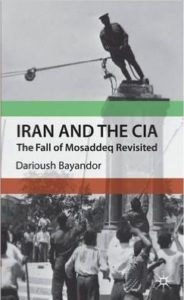درباره اسناد جدید سازمان سیا

درسا ل 2017 وزارت خارجه امریکا اسناد تازه ای درباره وقایعی که منجر به سرنگونی دولت ملی گرای دکتر محمد مصدق در مرداد 1332 شد از جمله اسناد توطئه آژاکس انتشارداد. در این خصوص داریوش بایندر نویسنده کتاب ایران و سازمان سیا در مقاله ای تحت عنوان «زبان صامت اسناد و رویداد بیست و هشتم مرداد 1332؛ چرا اسناد جدید سازمان سیا و وزارت خارجه امریکا روایت رایج در مورد سرنگونی دولت دکتر مصدق را تائید نمیکند؟» در ماهنامه اندیشه پویا، چاپ تهران شماره۴۴ مرداد۱۳۹۶ به بررسی جامعی از این اسناد پرداخته است
The Silent Voice of Archives; why the recently-released CIA secret documents do not confirm the commonly held assumptions on the fall of Mosaddeq?
In May 2017 the Department of State released a new batch of documents related to the CIA-MI6 plot (code named TP-Ajax) to overthrow Iran’s liberal-nationalist icon, prime-minister Mohammad Mosaddeq. The new release includes the bulk of the secret CIA files on the TP-Ajax planning and execution from April to September 1953. On this occasion the Iranian monthly magazine, andishe puya, in its Mordad 1396 issue (August 2017), has devoted a retrospective on the event to which several academics and specialists of that epoch, including Darioush Bayandor, Swiss-Iranian author of the book, Iran and the CIA, the Fall of Mosaddeq Revisited ( Palgrave.2010) contributed. In his 2010 book Bayandor had argued that following the failure of TP-AJAX coup on August 15, 1953 the CIA operatives in Tehran turned their attention to a different plan to foment tribal and military insurrections in southern Iran under the leadership of General Fazlollah Zahedi, in anticipation of a communist takeover of the capital. In this frame of mind the CIA missed a different dynamic which was at work following the flight of the Shah to Baghdad on the 16th propelled by the clerical hierocracy and which led to the overthrow of Mosaddeq on 19 August after the loyalist mid-ranking army officers joined the fray in early afternoon hours of that fateful day. The CIA chief operative in Tehran, Kermit Roosevelt, subsequently claimed that he had planned the events of 19 August and took credit for the fall of Mosaddeq. For decades academics as well as informed opinion have maintained that the fall of Mosaddeq was the result of the CIA intervention. In his book Bayandor dismissed Roosevelt’s post-factum claims as pure prevarication and distortion detailing his arguments to this effect in two elaborate chapters which are now confirmed by the declassified CIA files recently released. Among these files a cable transmitted by Roosevelt in very morning of 19 August [doc. 285, FRUS supplement 2017) reveal that he and his team had no clue about the events that were about to unfold in Tehran in the hours ahead.
***
La voix silencieuse des archives; pourquoi les documents secrets de la CIA ne confirment-t-ils pas le récit classique de la chute de Mosaddeq?
En mai 2017, le Département d’État a publié une nouvelle série de documents relatifs au complot de la CIA-MI6 (nom de code TP-Ajax) visant à renverser le gouvernement du Premier ministre Mohammad Mosaddeq, figure emblématique du libérale-nationalisme de l’Iran d’après-guerre. La nouvelle série inclut la majeure partie des fichiers secrets de la CIA sur le complot TP-Ajax, couvrant la période d’avril à septembre 1953. À cette occasion la revue mensuel iranienne, andishe puya, dans son édition de Mordad 1396 (août 2017), no. 44, a consacré une rétrospective sur l’événement à laquelle s’sont apportées leur contributions plusieurs universitaires et chercheurs spécialistes de cette époque dont Darioush Bayandor, auteur suisse-iranien de l’ouvrage, Iran and the CIA, the Fall of Mosaddeq Revisited (Palgrave.2010).
Dans cet ouvrage, Bayandor avait soutenu qu’après l’échec du coup d’état de TP-AJAX dans la nuit de 15-16 août, 1953, les agents de la CIA à Téhéran se sont penchés sur un plan différent visant à fomenter des insurrections tribales et militaires dans le sud de l’Iran sous la direction du Général Fazlollah Zahedi, ceci, en prévision d’une prise de contrôle communiste à Téhéran, inévitable selon leur estimation. Dans cet état d’esprit, la CIA aurait passé à côté d’une dynamique différente qui était à l’œuvre après la fuite du Shah à Bagdad au lendemain de l’échec du coup, le 16 août. Propulsé par la « hiérocratie » shiite, un mouvement de protestation surgisse dès les premiers heurs de la matinée du 19 août qui a conduit au renversement de Mosaddeq après que les officiers royalistes se sont joint la mêlée en début d’après-midi de cette journée fatidique. Le directeur d’opération de la CIA à Téhéran, Kermit Roosevelt, affirma par la suite qu’après l’échec de leur première tentative il aurait planifié les événements du 19 août. Ainsi, prendra-il crédit pour la chute de Mosaddeq. Pendant des décennies les milieux académiques ainsi que l’opinion avertie ont soutenus la thèse que la chute de Mosaddeq fut le fait de la CIA. Dans son livre Bayandor a rejeté les prétentions post factum de Roosevelt comme de pures fabrications en présentant une analyse soigneusement circonstancié qui est maintenant confirmée par les documents déclassifiés de la CIA. Parmi ceux-ci un câble transmis par Roosevelt le matin même du 19 août [doc. 285, supplément FRUS 2017] révèle que ce dernier et son équipe n’avaient la moindre idée des événements qui allaient se dérouler à Téhéran dans des minutes qui suivaient.
Here are the links to:
The book is also available from Amazon UK, France, Germany and an array of distributor world-wide. For its Farsi Translation see, Bijan Khalili, Sherkat Ketab, Los Angeles.

iran and the cia
iran va sazmane cia
Author: bayandor, darioush
Translator: dolatabadi, bijan
شرکت کتاب لس آنجلس
تاليف : بایندر،داریوش
مترجم : دولت آبادی، بیژن
To read more about this book : The Guardian August 17, 2016